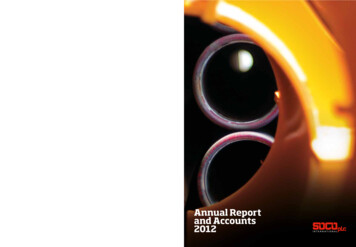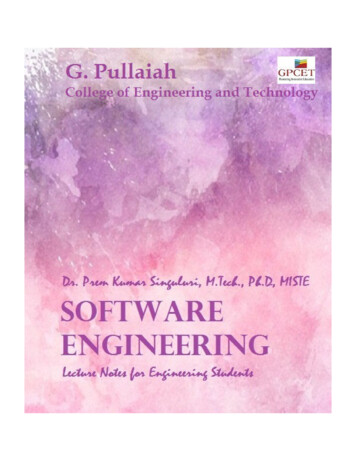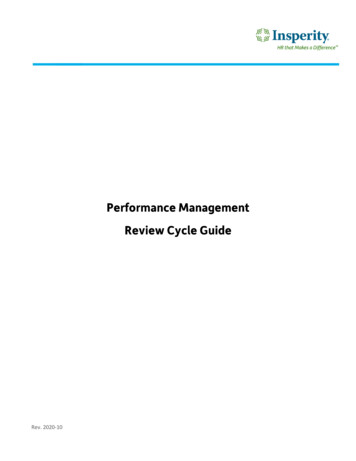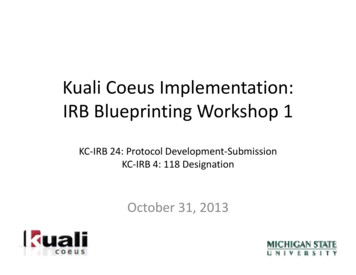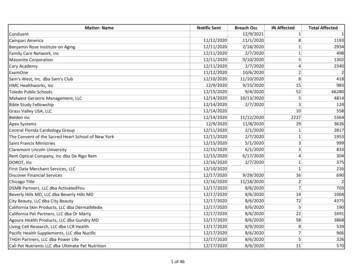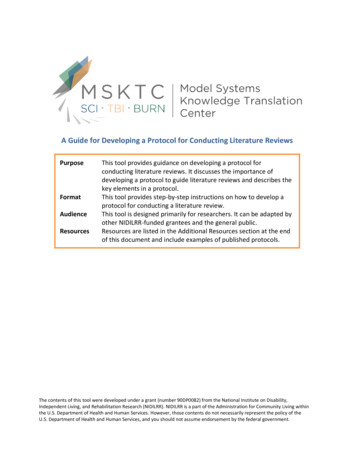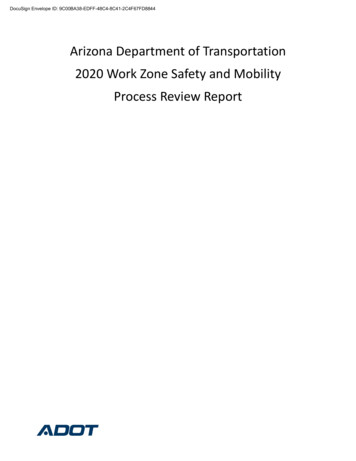
Transcription
DocuSign Envelope ID: 9C00BA38-EDFF-48C4-8C41-2C4F67FD8844Arizona Department of Transportation2020 Work Zone Safety and MobilityProcess Review Report
DocuSign Envelope ID: 9C00BA38-EDFF-48C4-8C41-2C4F67FD88442020 Work Zone Safety and Mobility Process Review ReportThis Work Zone Safety and Mobility Process Review Report was prepared by the Arizona Department ofTransportation (ADOT) and is evidence of Arizona’s Conformance with 23 CFR 630.1008(e) Subpart J & K.4/14/2021Approved By: Date:Dallas HammitDeputy Director for Transportation/State EngineerArizona Department of Transportation2020
DocuSign Envelope ID: 9C00BA38-EDFF-48C4-8C41-2C4F67FD88442020 Work Zone Safety and Mobility Process Review ReportContentsExecutive Summary. 1List of Abbreviations. 21. Background1.1 Background . 1-11.2 Committee Members. 1-1Table 1.2a - Committee Members. 1-22. Purpose and Objectives2.1 Purpose and Objectives . 2-13. Observations and Recommendations3.1 Observations . 3-13.2 Update Work Zone Safety & Mobility Policy . 3-13.3 Update to Implementation Guidelines for Work Zone Safety & Mobility(IGWZSM). 3-2Figure 3.3a Change in definition of significance. 3-2Figure 3.3b Updated ADOT Process for the identification, assessment, implementation andre-assessment of WZSM. 3-4Figure 3.3c Revision to FHWA Types of Work Zone Impacts. 3-5Figure 3.3d Change in Process Review Stages Flow Diagram. 3-63.4 TMP Template. 3-7Table 3.4.3a TMP RACI Table (Development). 3-7Table 3.4.3b TMP RACI Table (Construction). 3-83.5 Recommendations. 3-9Table 3.5a Potential Action Items. 3-103.6 Conclusion. 3-102020
DocuSign Envelope ID: 9C00BA38-EDFF-48C4-8C41-2C4F67FD88442020 Work Zone Safety and Mobility Process Review ReportAppendix A TMP Template . A-1Appendix B WZSM Policy .B-1Appendix C Implementation Guidelines for WZSM [2020] . C-1Appendix D 2014 Process Review.D-1Appendix E 2016 Process Review.E-1Appendix F 2018 Process Review.F-1Appendix G ADOT 2020 Update to the IGWZSM.G-1Appendix H ADOT 2020 Update to the WZSM Policy ENG 07-3.H-1Primary responsibility for inquiries regarding this document is theArizona Department of Transportation (ADOT),Transportation Systems Management & Operations Division (TSMO),Operational Traffic and Safety Group (OTAS)(602) 712-22122020
DocuSign Envelope ID: 9C00BA38-EDFF-48C4-8C41-2C4F67FD88442020 Work Zone Safety and Mobility Process Review ReportExecutive SummaryTitle 23 of the Code of Federal Regulation (23 CFR) 630.1008 (e) or sometimes referred to as “The Rule”requires ADOT to conduct a biennial Process Review (PR) of work zones, and states that the ultimateobjective of a PR is to enhance efforts to address safety and mobility on current and future projects.The majority of the content in this PR reviews and highlights the improvements to ADOT’s Work ZoneSafety and Mobility (WZSM) program due to the accomplishments of the Work Zone Safety andMobility Committee (WZSMC) within the past two years. The WZSMC acknowledges that while anevaluation like the Capability Maturity Framework (CMF) was not completed, an assessment of whatneeded improvement within the ADOT WZSM program was completed.ADOT has a successful WZSM program. Previous PRs have repeatedly identified that ADOT meets therequirements set forth by the Federal Highway Administration (FHWA) in 23 CFR. The 2019-2020WZSMC evaluated ADOT’s WZSM program and assessed that focusing on Transportation ManagementPlans (TMPs) would help strengthen the program. During the work on TMP, the WZSMC found that theADOT documents “Implementation Guidelines for Work Zone Safety and Mobility” and “Work ZoneSafety and Mobility Policy ENG 07-3” needed to be updated in order to achieve the desired results ofimproving TMP development.The specific purpose of this PR is to evaluate ADOT's Policy, Implementation Guidelines, and TMPprocess. A detailed summary of work the WZSMC has completed on updates to the ImplementationGuidelines and Policy is provided in Appendix G and H. The WZSMC also created a TMP Template to aidthe improvements on TMPs which can be found in Appendix A.ADOT continues to improve upon their healthy work zone safety and mobility program and shouldcontinue with work in-progress while implementing the recommendations found within this report asappropriate.1
DocuSign Envelope ID: 9C00BA38-EDFF-48C4-8C41-2C4F67FD88442020 Work Zone Safety and Mobility Process Review ReportList of AbbreviationsACTADOT Communications TeamADEAssistant District EngineerADOTArizona Department of TransportationCATConstruction Advisory TeamCFRCode of Federal RegulationsCMFDECapability Maturity FrameworkDistrict EngineerDOTDepartment of TransportationDPSDepartment of Public Safety (Uniformed Officers)ECDEnforcement and Compliance DivisionERTEmergency Response TeamEVAPEmergency Vehicle Access PlanFHWAFederal Highway AdministrationIDOIGWZSMInfrastructure Delivery & Operations DivisionImplementation Guidelines for Work Zone Safety & MobilityPIOPublic Information OfficerPMProject ManagerPRProcess ReviewRACIREResponsibility, Accountability, Consultation, and InformedResident EngineerRTERegional Traffic EngineerTIMTraffic Incident ManagementTISTraveler Information System (AZ511)TMPTransportation Management PlanTOCTraffic Operations CenterTSMOWZSMWZSMCTransportation Systems Management and Operations DivisionWork Zone Safety and MobilityWork Zone Safety and Mobility Committee2
DocuSign Envelope ID: 9C00BA38-EDFF-48C4-8C41-2C4F67FD88442020 Work Zone Safety and Mobility Process Review ReportChapter 11.1BackgroundPRs are a Federal requirement but are State-led and are not to be confused with FHWA Work Zone SelfAssessment or Conformance Reviews. The Work Zone Self Assessment is a survey that the Departmentfills out with FHWA’s guidance. The Self Assessment is ideally completed by a multidisciplinary teamfrom within the Department (Construction, Traffic Operations, Communications, Design, etc.) and canbe facilitated by someone from the FHWA Division office. The Conformance Reviews are to determine ifall applicable standards (national, state, or local) have been met. Conformance reviews are tied to ourstewardship agreement with FHWA; the language addressing it comes from 23 CFR 630.1014:Each State shall work in partnership with the FHWA in the implementation of its policies andprocedures to improve work zone safety and mobility. At a minimum, this shall involve an FHWA reviewof conformance of the State’s policies and procedures with this regulation and reassessment of theState’s implementation of its procedures at appropriate intervals. Each State is encouraged to addressimplementation of this regulation in its stewardship agreement with the FHWA.The WZSMC found the implementation and content of the TMP specification is inconsistent, as it wasfound in previous years. The subject of a standard stored specification for TMPs was brought beforethe ADOT Standards Committee where a consensus could not be reached due to differing opinions onwhether or not this was the ultimate responsibility of the designer or contractor. The StandardsCommittee asked that this be brought before the Sub-program Project Initiation Review Board (SuPIRB)for further discussion. SuPRIB recommended the TMP be a responsibility of the contractor and sent itback to the Standards Committee. The Standards Committee then recommended that the WZSMCdevelop a TMP standard specification for review and implementation.1.2Committee MembersThe standing WZSMC that conducted the 2020 WZSM PR included Todd Emery, Deputy DivisionDirector for IDO, as the committee sponsor and representative from the SEO, along with ADOTrepresentatives from MPD, TSMO, and IDO. The WZSMC chairman, historically, is a rotating positionthat is assigned by the State Engineer every two years. Recently, the chairman has been a DistrictEngineer. The WZSMC co-chairman is a representative of the TSMO Operational Traffic & SafetyGroup, assigned by WZSMC. There were two representatives from MPD. There were a total of sixrepresentatives from TSMO, which included the Regional Traffic, Operations, Traffic Safety, SystemsTechnology, and Traffic Management Groups. There were two representatives from Communications.Ten members were from IDO which included representatives from Construction, Project Management,Resident Engineers, District Engineers, Traffic Design, and Materials Groups. Finally, two FHWArepresentatives were included. Although there are a few more groups defined and represented thanas prescribed by the Implementation Guidelines, the intent of the guidelines was met.1-1
DocuSign Envelope ID: 9C00BA38-EDFF-48C4-8C41-2C4F67FD88442020 Work Zone Safety and Mobility Process Review ReportTable 2.1a - Committee MembersVoting Members “X”Todd Emery (Sponsor)TEmery@azdot.govADOT State Engineer’s OfficeXKurt Harris (2020 Chair)RKHarris@azdot.govADOT IDO SouthEast DistrictXAdam Carreon (2020 Co-Chair)ACarreon@azdot.govADOT TSMO OperationsXJames GomesJGomes@azdot.govADOT TSMO Regional TrafficXKerry WilcoxonKWilcoxon@azdot.govADOT TSMO Traffic SafetyXSusan AndersonSEAnderson@azdot.govADOT TSMO Systems TechnologyXDerek ArnsonDArnson@azdot.govADOT TSMO Traffic Management (TOC)Mark Brownmbrown4@azdot.govADOT TSMO Traffic ManagementDouglas PaceyDPacey@azdot.govADOT CommunicationsCourtney Kingcking3@azdot.govADOT CommunicationsBill Faybfay@azdot.govADOT IDO Construction GroupXAnthony Brozichabrozich@azdot.govADOT IDO Construction GroupXDerek BolandDBoland@azdot.govADOT IDO Project ManagementCraig Regulskicregulski@azdot.govADOT IDO Project ManagementKirstin Hustonkhuston@azdot.govADOT IDO Project ManagementDan Casmerdcasmer@azdot.govADOT IDO Resident EngineerKole Deakdea@azdot.govADOT IDO Resident EngineerXHasina LunaHLuna@azdot.govADOT IDO Traffic DesignXJesus Sandoval-giljsandoval-gil@azdot.govADOT IDO MaterialsXClemenc Ligockicligocki@azdot.govADOT MPDDaniel Gabioudgabiou@azdot.govADOT MPDToni WhitfieldToni.Whitfield@dot.govFHWA Arizona DivisionAmmon HeierAmmon.Heier@dot.govFHWA Arizona DivisionXX1-2
DocuSign Envelope ID: 9C00BA38-EDFF-48C4-8C41-2C4F67FD88442020 Work Zone Safety and Mobility Process Review ReportChapter 2Purpose and Objectives2.1Purpose and ObjectivesThe purpose of this biennial PR is to evaluate the agency’s WZSM policy, processes and procedures,data and information resources, and training programs to assess the effectiveness of a work zoneprogram. Managing traffic in work zones is necessary to minimize traffic delays, maintain motorist andworker safety, complete roadwork in a timely manner, and maintain access for businesses, institutions,and residents. WZSM PRs help assess the effectiveness of the work zone program policies, guidelines,and procedures. The review is to enable ADOT and the FHWA to confirm where a problem does or doesnot exist, or to identify systemic problems, and make recommendations to improve situations whereshortcomings are found. It is also used to identify Best Practices. The specific purpose of the 2020 PRwas to evaluate the Policy, Implementation Guidelines, and the TMP process.2-1
DocuSign Envelope ID: 9C00BA38-EDFF-48C4-8C41-2C4F67FD88442020 Work Zone Safety and Mobility Process Review ReportChapter 3Observations and Recommendations3.1Initial ObservationsThe WZSMC found the implementation and content of the TMP and specification is inconsistent, as itwas found in previous years. The WZSMC decided the contractor should not bear the soleresponsibility of the TMP, and that on most projects (that are design-bid-build) the opportunity tooutline many parts of the TMP prior to construction would be overlooked. Development is also theideal time to start stakeholder engagement. The consensus of the WZSMC was that the creation of theTMP should be during the development process, and become a living document that gets handed offfrom designer to contractor.Although not part of the initial observations of the WZSMC, updates were also made to theImplementation Guidelines. These updates are included here within, as they guide the overall programand improve WZSM processes.3.2Update to WZSM PolicyThe SEO engaged the WZSMC in the update process of the WZSM Policy (ADOT Policy ENG 07-3).Having a WZSM Policy is a requirement of The Rule. The update came into effect on September 16,2020 and can be found in Appendix B, with a detailed list of the changes in Appendix H.The policy is a central guiding document for the WZSM processes. Some notable changes, and thereason behind them, the WZSMC made to improve work zone safety and mobility include:1.2.3.4.5.6.7.Add the definition of ‘Incident’Inclusion of ADOT Traffic Operations Center (TOC) was also previously excluded.Addition of Traffic Incident Management (TIM)The definition of Work Zone Safety was expanded. This clarification adds a measurementfor safety. Effective safety measurement empowers you with quantifiable evidence of whatis or isn't working. Furthermore, if you use effective data and indicators, safetymeasurement can even enable you to determine why something isn't working.Updated language about what to do with the data that is collected. This follows the samelogic of previous changes to the policy about the importance of measuring performance.Changes to allow for flexibility in process review, which also allows for focusing onSignificant projects, without excluding projects that are not (subsection D).The important change to subsection E was to more clearly define that a project was to beidentified as Significant before scoping. This was an important clarification to the WZSMprocess and the WZSMC. The previous language of “Early in development” could mean amultitude of points within a project life. Adding scope requires additional funds, a contractmodification, pricing, and time consuming negotiations. The remainder of the definition3-1
DocuSign Envelope ID: 9C00BA38-EDFF-48C4-8C41-2C4F67FD88442020 Work Zone Safety and Mobility Process Review Report8.3.3was removed, because this is already clarified in the federal requirements, and the WZSMCwas not aware of a single project where it has been used.Finally an entirely new section ‘J’ was added for incident management. Incidentmanagement is an important strategy to be considered in the transportation operationscomponent of the TMP. The goals, objectives, and reasons for incident management aswell as the issues and concerns that incident responders and TOC employees need toconsider are critical to a successful work zone.Update to Implementation Guidelines for Work Zone Safety & MobilityThe WZSMC was also engaged to update the Implementation Guidelines for Work Zone Safety andMobility. As with the policy, the Implementation Guidelines steer much of the processes involved inour work zone program. The WZSMC used this as another opportunity to help prove the overallprogram.Another change was to remove the signatory section of the Implementation Guidelines. The originalImplementation Guidelines was signed by the ADOT Director, State Engineer, Multimodal PlanningDivision Director, and Director of Communication and Community Partnerships. The need orrequirement of the signatures was brought up during the revision process. The WZSMC researchedpractices of other DOTs and did not find a single signature of approval on any other statesimplementation guidelines. It is important to note that ADOT has adopted a Lean Business Model thatis reflected in many of the changes to the Implementation Guidelines. “Lean" is considered aphilosophy of continuous improvement. A lean organization focuses on increasing customer value, theelimination of waste, and optimizing operations. Removing the signatures allows the flexibility tochange specific elements in a more efficient manner and eliminate any “muda”, or waste, associatedwith collecting signatures of unaffected parties. This allows the WZSMC to make changes and updatesto the Implementation Guidelines in the most efficient manner possible.All of the other changes to Implementation Guidelines are not described within this document as thisnot the appropriate vehicle to do so. Only items critical to improving the agency's work zone policy,processes and procedures, data and information resources, and training programs to assess theeffectiveness of a work zone program are noted. These changes are outlined in the followingparagraphs.The introduction clarifies the new definition of significance for projects, eliminating the previous“Major and Minor” levels and replacing them as shown in Figure 3.3a below.Figure 3.3aChange in Definition of Significance3-2
DocuSign Envelope ID: 9C00BA38-EDFF-48C4-8C41-2C4F67FD88442020 Work Zone Safety and Mobility Process Review ReportThe WZSM Policy is now included as text, instead of as a picture as it was previously presented, whichallows it to be a searchable part of the overall document. The previous policy format was included as anon-searchable picture. The biggest advantage of being searchable is it can save time. You can use afew tools like windows file search or command line to search for desired information. This also allowscolleagues to open and copy data from the file, which enhances the overall value. This also allows theImplementation Guidelines to be easier to find online and in search results. This enhances thecustomer experience with increased accessibility. A scanned document is just an image of a textdocument and is therefore inaccessible for a disabled person, you can not extract the words or read thedocument using an assistive technology software. By adding the policy as searchable text it saves time,increases productivity, and improves the end-user experience.“ADOT’s process for the identification, assessment, implementation and re-assessment of WZSM”, waschanged from a linear flow chart to a circular model to mimic our continuous improvement strategy, orthe Lean Business Model [See Figure 3.3b Updated WZSM Process].3-3
DocuSign Envelope ID: 9C00BA38-EDFF-48C4-8C41-2C4F67FD88442020 Work Zone Safety and Mobility Process Review ReportFigure 3.3bUpdated ADOT Process for the Identification, Assessment, Implementation and Re-assessment of WZSM3-4
DocuSign Envelope ID: 9C00BA38-EDFF-48C4-8C41-2C4F67FD88442020 Work Zone Safety and Mobility Process Review ReportThere were a number of updates to the WZSM Procedure table. For the first activity in the procedure,the tasks were almost completely revised. Most important to note is that projects are no longerdesignated as minor or major. Being that the designation as Significant relative to WZSM (and notenvironmentally) is critical to do as early as possible. The WZSMC met with ADOT MPD to discuss howto do this accurately. The team members agreed to the following revised task:“Projects within a TMA and an access controlled divided highway will be marked as "Significant forWZSM" and will include the conception of a four part TMP during the scope of the project.The twoadditional parts of the TMP can be removed at a later stage if the project team deems that the projectis not a Significant project.”Tasks related to training were completely rewritten to focus on operations, new technologies, and datacollection through SMZs. Two of these new tasks are: Training on new technologies should be a continued practice that is renewed as technologychanges.Smart Work Zone (SWZ) items and specifications should always be included on Significantprojects.One improvement of note was the revision of the figure for Types of Work Zone Impacts as shown inFigure 3.3c, a revision made to match existing Federal documentation, The change was to add“Environmental Impacts (noise, dust,etc.)” as a type of Work Zone Impacts. This is a small but verysubstantial addition as environmental impacts can be the most significant and impactful to the projectand the public.3-5
DocuSign Envelope ID: 9C00BA38-EDFF-48C4-8C41-2C4F67FD88442020 Work Zone Safety and Mobility Process Review ReportFigure 3.3cRevision to FHWA Types of Work Zone Impacts3-6
DocuSign Envelope ID: 9C00BA38-EDFF-48C4-8C41-2C4F67FD88442020 Work Zone Safety and Mobility Process Review ReportWithin Chapter 8, Process Reviews, the process flow chart was changed from a linear format to circularto match the Lean Process. One interesting finding was that in the original process the final task was to“Apply recommendations and lessons learned”, but this logic was not shown on the flow diagram tocomplete the loop back as with the revised format. These diagrams are shown in Figure 3.3d Change inProcess Review Stages Flow Diagram below.3-7
DocuSign Envelope ID: 9C00BA38-EDFF-48C4-8C41-2C4F67FD88442020 Work Zone Safety and Mobility Process Review ReportFigure 3.3dChange in Process Review Stages Flow Diagram3-8
DocuSign Envelope ID: 9C00BA38-EDFF-48C4-8C41-2C4F67FD88442020 Work Zone Safety and Mobility Process Review Report3.4TMP TemplateDevelopment of a standard template for TMPs was chosen by the WZSMC as a priority before creatinga specification since it would require the WZSMC to take a closer look at what goes into a TMP andtherefore help it write a better specification. Once the roles and responsibilities were defined withinthe TMP Template, a specification could be more easily written. The latest version of the TMPTemplate is located in Appendix A.One item that is worth elaborating on within the TMP is the Responsibility, Accountability,Consultation, and Informed (RACI) Tables. The RACI table is the appropriate method for communicatingthis critical information within a project. The ‘R’ stands for Responsible and defines who does thework. The ‘A’ stands for Accountable and defines who is to review or ensure the work is getting done.The ‘C’ stands for Consulted and defines who is needed for input. Finally, the ‘I’ stands for Informed asneeded and defines who is kept in the loop on progress. This exercise in creating the RACI tableredefined the Transportation Management Measures and Roles that were used. Two tables werecreated, one for the development process and one for during construction. The WZSMC sees thesetables as another very helpful step in creating consistency with TMPs statewide.Table 3.4aTMP RACI Table (Development)3-9
DocuSign Envelope ID: 9C00BA38-EDFF-48C4-8C41-2C4F67FD88442020 Work Zone Safety and Mobility Process Review ReportTable 3.4bTMP RACI Table (Construction)3-10
DocuSign Envelope ID: 9C00BA38-EDFF-48C4-8C41-2C4F67FD88442020 Work Zone Safety and Mobility Process Review Report3.5Findings & Recommendations3.5.1Findings1. There is a need for a TMP Template, however development of the Template has not beenfinalized.a. Consensus could not be reached on who should be responsible for the creation andimplementation of a TMP .b. Development of a standard specification for TMPs has not been completed.c. A sample of Significant projects contained all four components of a TMP, however nostandard format has been established.d. From the 2016 PR; the team identified Business Practices, especially the implementationof TMPs as one of the areas that is being done in a systematic way, but the team foundthat there could be improvements. Some team members noted that there is oftenexcess information in TMPs.2. Updates were made in 2020 to the WZSM Policy and Implementation Guidelines.3. The WZSMC is continuously making improvements to the WZSM program.4. Finding from FHWA: It could be helpful to develop a spreadsheet of all findings andrecommendations as a running log of potential action items or a 2-, 3-, 5-, 10-year actionplan. ADOT could keep track of items addressed, not addressed, reason for not addressing,etc. Whenever it seems appropriate to address a finding from a process review or someother source, then it can be addressed and marked completed on the spreadsheet. Thefindings can be ranked by priority if it is reasonable to do so.5. Finding from FHWA: Goals should be established for each Process Review so there isdirection in completing the review, “the goal does not have to be complex. The goal can besimplified and focused. i.e., Evaluate ADOT’s use of TMPs from a random sample of projectsor random sample of REs.”6. Finding from FHWA: ADOT should consider “use of the ADOT on-call contract for technicalediting and/or writing. This could help take the load off formatting/writing and focus on theintent of the document, which is evaluating effectiveness of the program. The contact formore information on the on-call contract is through ADOT MPD.”3.5.2Recommendations1. The WZSMC should continue its work towards finalizing a TMP Template.a. The contractor should not bear the sole responsibility of the TMP, projects (that aredesign-bid-build) have a missed opportunity to outline many parts of the TMP prior toconstruction if it is automatically relegated to the contractor. Development is also theideal time to start stakeholder engagement. The consensus of the WZSMC was that thecreation of the TMP should be during the development process, and become a livingdocument that gets handed off from designer to contractor.b. With the use of the documents as shown in Appendix A, B, & C by project teams,comments are to be expected. The WZSMC recommends to create a standardspecification for TMPs with consideration of the comments received.3-11
DocuSign Envelope ID: 9C00BA38-EDFF-48C4-8C41-2C4F67FD88442020 Work Zone Safety and Mobility Process Review Report2.3.4.5.6.c. The Template will provide standardization of the format of the TMP components.d. Reduce the length of TMPs by removing extraneous information, and developstandardized language for specifications.No further action is required unless changes, updates, or additions are needed to the WZSMPolicy and Implementation Guidelines.The WZSMC should continue its progress and the representative from the Operational Trafficand Safety Group should remain as co-chair of the PR to support the continuity of the WZSMCsefforts.Develop a spreadsheet as described in Finding No. 4 above. A potential example is shown inTable 4.2a below.In considering FHWA’s recommendation, the 2022 PR goal is to evaluate ADOT’s implementationof SMZs from a random sample of projects.Look into the use of a 3rd party for assistance in preparation of the next PR.Finding or RecommendationGoal Date ofCompletionPriorityNotes/Reason for not addressingCompletedTable 3.5.2aPotential Action Items3.5ConclusionThe information provided within this PR documents continuous improvement toward the implementationof the work zone best practices. The practices at ADOT are consistent with the work zone managementprinciples promoted by the Rule. ADOT continues to promote and improve upon their sound work zonemanagement practices leading to reduced congestion and delay while improving safety in and aroundwork zones.3-12
DocuSign Envelope ID: 9C00BA38-EDFF-48C4-8C41-2C4F67FD88442020 Work Zone Safety and Mobility Process Review ReportAppendix A: Transportation Management PlanTemplateA-1
DocuSign Envelope ID: 9C00BA38-EDFF-48C4-8C41-2C4F67FD88442020 Work Zone Safety and Mobility Process Review ReportAppendix B: 2020 Work Zone Safety andMobility Policy ENG 07-3B-1
RACI Responsibility, Accountability, Consultation,and Informed RE Resident Engineer RTE Regional Traffic Engineer TIM Traffic Incident Management TIS Traveler Information System (AZ511) TMP Transportation Management Plan TOC Traffic Operations Center TSMO Transportation Systems Management and OperationsDivision WZSM Work Zone Safety and Mobility



